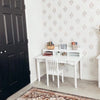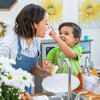Best Types of Toddler Toys by Age

Shopping for adults is hard. Shopping for toddlers? That’s easy. They’ll be excited to open almost anything, and if you stick to classic toys that match their developmental stage, they’ll actually play with it – sometimes for years to come! To simplify your buying while still keeping your options open, our guide breaks down some of the best categories of toys for infants, toddlers, preschoolers, and beyond!
Toys for Infants (7-12 months)
Bead Mazes
Bead mazes are an ideal developmental toy for babies because they allow for fine motor practice with small objects without creating a choking hazard. Small pieces are big no-no for kids under three due to their tendency (aka compulsive need) to put everything in their mouth. The downside is those tiny objects are the perfect size for their little hands to explore and manipulate. Bead mazes solve that! Tiny pieces are fully attached to the toy but mobile enough that they can still practice spinning and sliding them around.
Push Toys
Most babes in this age range are just starting to find their sea legs – they’re pulling up, practicing standing on their own for a bit, and maybe even taking those first wobbly steps as early as nine or ten months. Pushcarts are a great way to support those developing skills. Look for ones that are sturdy enough that they won’t tip over when little ones use them to pull up but just light enough that they can start pushing them forward.
Toys for 1 Year Olds
Blocks
Did you know a toddler’s ability to stack blocks is used as a milestone to track their development? Babies 14-20 months should be able to stack two blocks, and two-year-olds should be able to stack four. Why? It’s a strong indicator of how their fine motor skills are developing. Start playing together with blocks by at least one year old (or even sooner) to give them plenty of opportunities to practice.
Shape Sorters
Shape sorters provide another great way for toddlers to practice fine motor skills, but they also help them build shape recognition and problem-solving skills. Babies under 18 months will do best with simple shapes and just a few holes, and don’t be surprised if they need a tone of help choosing the right shape and fitting it into the hole. Once they start to master that, you can progress to larger shape sorters with tougher-to-recognize shapes, but again, they’re likely to need lots of help to master the new challenge!
Toys for 2 Year Olds
Climbers
There’s no doubt that two-year-olds love to move, and they’re well-known for turning all of your furniture into their own personal playground. Giving them safe, appropriate ways to explore the urge to climb can help them meet that developmental need (and spare your couch cushions). Climbers are an affordable way to provide just that, letting them expend some of that energy, get some outdoor play, and develop gross motor skills in the process.
Baby Dolls
Hands down, our favorite thing about year two is watching their pretend play really take off! But unlike older kiddos who will start to invent their own characters and storylines, two-year-olds ’ pretend play is often based on what they see in real life. Dolls are ideal for just that, letting them act out roles and actions they see every day. While they may also show interest in smaller dolls and dollhouses at this age, larger dolls and doll furniture are a bit easier for them to handle and manipulate. Plus, they’re a great way to help prepare them for a younger sibling!
Toys for 3 Year Olds
Train Sets
Train sets hit some of the types of play three-year-olds are working to develop: elaborate pretend play with storylines and constructive play (i.e. building and creating). Playing with trains is often a multi-step process that develops several different skills. Assembling the tracks is like a combination of puzzles and blocks; they’ll develop planning, problem-solving, and fine motor skills as they fit the pieces together and plan their track. Then, they can move into pretend play as they chug the train down the tracks and play with any included characters and prop pieces.
Play Kitchens
Toys like play kitchens are perfect both for letting three-year-olds mimic what you do in real life and eventually adding their own creative pretend scenarios. We like to go for smaller, toddler-sized play kitchens for this age. They can reach everything easily and are less likely to get overwhelmed by too many choices.
Toys for 4 Year Olds
Craft Tables
Your kids have probably loved using colors and paints for years, but now, they’re really starting to get creative and meticulous with their arts and crafts. A space that allows them to easily access a variety of materials (think popsicle sticks, glue, craft pom poms, safety scissors, and various paints and colors) will let them move beyond adult-directed crafts and really start to explore their creativity. It’s best if all those materials can stay somewhat organized so they won’t get overwhelmed or frustrated as they search for what they need. Craft tables with built-in storage are a great solution. And since many children are starting preschool at this age, craft tables can give them practice sitting and staying focused and using the same materials they use in class.
Playhouses
Imaginative play is growing more complex for four-year-olds, and with a friend or sibling, they can get lost in their own pretend worlds for hours. Dress up clothes and large toys that foster role play are always going to be a hit. Playhouses are a great open-ended toy that lets four-year-olds immerse themselves in their own pretend world, whether that means performing daring firefighter rescues from a burning building, hosting a tea party in their castle, or running their own vet clinic.
Toys for 5 Year Olds
Outdoor Play Sets
With most kids starting full-time kindergarten at this age, they’ll be itching to get some energy out after a long day in the classroom (and to hit the pillow a little early each night!) And since no one has time to hit the park after school and get dinner ready, adding a swingset to the backyard can make it way easier to let the kids get the movement and outdoor play they crave.
Dollhouses & Play Sets
Your child’s social circle grows dramatically once they start kindergarten, so expect plenty of playdates (and maybe even a sleepover or two in the next couple of years). Dollhouses are classic for fostering engaging social play – look for one that’s the right size for the dolls your child is into at the moment. At this age, that’s usually 12” dolls like Barbies and LOL Dolls or 18” dolls like American Girl or Our Generation. If your child loves the type of play you do with dollhouses but doesn’t love dolls, playsets like our Deluxe Fire Rescue Set or Pirate’s Cove Play Set are a great alternative and perfect for action figures!














